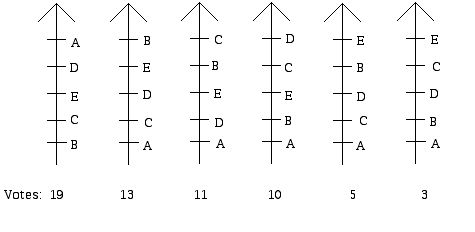Prepared by:
Joseph Malkevitch
Department of Mathematics
York College (CUNY)
Jamaica, New York 11451
email:
malkevitch@york.cuny.edu
web page:
http://york.cuny.edu/~malk
Given the election below:
 Determine the winner (if there is one) using the methods:
Determine the winner (if there is one) using the methods:a. Plurality
b. Condorcet
(As part of your solution draw a digraph which shows who beats whom. Use a directed edge from X to Y if X beats Y in a two-way contest.)
c. Borda count
(as part of your solution construct a pairwise preference matrix.)
d. Sequential run-off
e (Standard) Run-off
---------------------------------------------
f. Borda count sequential run-off
g. Coombs
h. Bucklin
Bucklin works as follow: If no one wins a majority based on the first place votes, look at only first and second place votes, to see if someone now has a majority. Continue until a winner emerges.
2. a. Add 2 to each of the votes at the bottom of the columns for the elections in Question 1. This means adding 12 additional votes to the total so there are now a total of 73 voters. Redo all of the parts Question 1 with the new data for voter preferences.
b. What changes if any do you note in the outcomes of the election using the different methods explored in 1?
c. Does b. suggest any "general theorems" about the way elections behave when the same constant is added to the number of votes for each different type of preference schedule that make up the election?